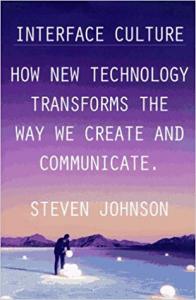
"As our machines are increasingly jacked into global networks of information, it becomes more and more difficult to imagine the dataspace at our fingertips, to picture all that complexity in our mind's eye . . . Representing all that information is going to require a new visual language, as complex and meaningful as the great metropolitan narratives of the 19th-century novel."--from Interface Culture
In this hip, erudite manifesto, Steven Johnson--one of the most influential people in cyberspace, according to Newsweek bridges the gap that yawns between technology and the arts. Drawing on his own expertise in the humanities and on the Web, he not only demonstrates how interfaces--those buttons, graphics and words on the screen through which we control information--influence our daily lives, but also tracks their roots back to Victorian novels, early cinema and even medieval urban planning. The result is a lush cultural and historical tableau in which today's interfaces take their rightful place in the lineage of artistic innovation.
With Interface Culture, Johnson brilliantly charts the vital role interface design plays in modern society. Just as the great novels of Melville, Dickens and Zola explain a rapidly industralizing society to itself, he argues, web sites, Microsoft Bob, flying toasters and the landscapes of video games tell the digital society how to imagine itself and how to get around in cyberspace's unfamiliar realm.
The role once played by novelists is now fulfilled by the interface designer, who has bridged the gap between technology and everyday life by providing a conceptual framework for the vast amounts of information and computation that surround us.
Johnson boldly explores the past--a terrain few tech thinkers have dared enter, and one that throws dazzling light on the modern interface's roots. From the great cathedrals of the Middle Ages to the rise of perspective drawing in the Renaissance, from Enlightenment satire to the golden age of television, Interface Culture uses a wealth of venerable "interface innovation" to place newfangled creations like Windows 95 and the Web in a rich historical context.
Controversial, clear-sighted and challenging, Interface Culture also looks at the future--from what PC screens will look like in 10 years to how new interfaces will alter the style of our conversation, prose and thoughts. With a distinctively accessible style, Interface Culture brings new intellectual depth to the vital discussion of how technology has transformed society, and is sure to provoke wide debate in both literary and technological circles.
"As our machines are increasingly jacked into global networks of information, it becomes more and more difficult to imagine the dataspace at our fingertips, to picture all that complexity in our mind's eye . . . Representing all that information is going to require a new visual language, as complex and meaningful as the great metropolitan narratives of the 19th-century novel."--from Interface Culture
In this hip, erudite manifesto, Steven Johnson--one of the most influential people in cyberspace, according to Newsweek bridges the gap that yawns between technology and the arts. Drawing on his own expertise in the humanities and on the Web, he not only demonstrates how interfaces--those buttons, graphics and words on the screen through which we control information--influence our daily lives, but also tracks their roots back to Victorian novels, early cinema and even medieval urban planning. The result is a lush cultural and historical tableau in which today's interfaces take their rightful place in the lineage of artistic innovation.
With Interface Culture, Johnson brilliantly charts the vital role interface design plays in modern society. Just as the great novels of Melville, Dickens and Zola explain a rapidly industralizing society to itself, he argues, web sites, Microsoft Bob, flying toasters and the landscapes of video games tell the digital society how to imagine itself and how to get around in cyberspace's unfamiliar realm.
The role once played by novelists is now fulfilled by the interface designer, who has bridged the gap between technology and everyday life by providing a conceptual framework for the vast amounts of information and computation that surround us.
Johnson boldly explores the past--a terrain few tech thinkers have dared enter, and one that throws dazzling light on the modern interface's roots. From the great cathedrals of the Middle Ages to the rise of perspective drawing in the Renaissance, from Enlightenment satire to the golden age of television, Interface Culture uses a wealth of venerable "interface innovation" to place newfangled creations like Windows 95 and the Web in a rich historical context.
Controversial, clear-sighted and challenging, Interface Culture also looks at the future--from what PC screens will look like in 10 years to how new interfaces will alter the style of our conversation, prose and thoughts. With a distinctively accessible style, Interface Culture brings new intellectual depth to the vital discussion of how technology has transformed society, and is sure to provoke wide debate in both literary and technological circles.











